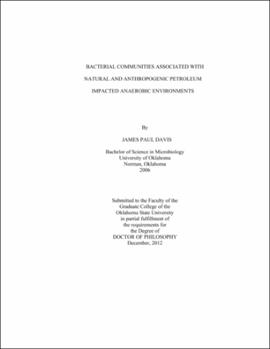| dc.contributor.advisor | Elshahed, Mostafa S. | |
| dc.contributor.author | Davis, James Paul | |
| dc.date.accessioned | 2013-11-26T08:26:09Z | |
| dc.date.available | 2013-11-26T08:26:09Z | |
| dc.date.issued | 2012-12 | |
| dc.identifier.uri | https://hdl.handle.net/11244/6843 | |
| dc.description.abstract | Scope and Method of Study: The aim of this dissertation was to determine the diversity, abundance, distribution, and morphology of candidate division SR1 from various habitats (including a natural gas impacted fresh water spring), and to determine the spatial and temporal changes in the bacterial communities associated with two newly drilled natural gas wells. Methods: Oligonucleotide primer and probe design; bulk DNA extraction from environmental samples; Polymerase Chain Reaction (PCR); quantitative PCR; Phylogenetic and diversity analysis; Fluorescence in situ hybridization; Beta-diversity analysis | |
| dc.description.abstract | Findings and Conclusions: This work demonstrates the complexity of the bacterial communities associated with natural gas environments. Candidate division SR1 appears to be only found in anaerobic environments, and certain environmental conditions allow for this "rare biosphere" division to be a more prominent member of the bacterial community. It has been shown that SR1 has two morphotypes: filamentous and rod, and that cellular morphology was linked to phylogeny. The second half of this work demonstrated that the bacterial populations associated with natural gas well equipment fluctuate over time and space. The majority of the sequences were classified in the phyla: Firmicutes and Proteobacteria (classes Gamma- and Epsilonproteobacteria). Overall, the bacterial communities are halotolerant/halophilic with many hydrocarbon-degrading lineages. There was a significant sulfidogenic bacterial consortia present that increased over time. The bacterial communities in each well showed an increase in community similarity over time in each component. Spatially, the bacterial communities in the tanks were significantly different from the separators. The drilling mud and frac-water communities were not significantly similar to the production water communities in both wells. | |
| dc.format | application/pdf | |
| dc.language | en_US | |
| dc.rights | Copyright is held by the author who has granted the Oklahoma State University Library the non-exclusive right to share this material in its institutional repository. Contact Digital Library Services at lib-dls@okstate.edu or 405-744-9161 for the permission policy on the use, reproduction or distribution of this material. | |
| dc.title | Bacterial communities associated with natural and anthropogenic petroleum impacted anaerobic environments | |
| dc.contributor.committeeMember | Miller, Robert V. | |
| dc.contributor.committeeMember | Hoff, Wouter D. | |
| dc.contributor.committeeMember | Fathepure, Babu Z. | |
| dc.contributor.committeeMember | Melcher, Ulrich | |
| osu.filename | Davis_okstate_0664D_12377.pdf | |
| osu.accesstype | Open Access | |
| dc.type.genre | Dissertation | |
| dc.type.material | Text | |
| dc.subject.keywords | 16s | |
| dc.subject.keywords | culture-independent | |
| dc.subject.keywords | microbiology | |
| dc.subject.keywords | petroleum | |
| dc.subject.keywords | sr1 | |
| dc.subject.keywords | zodletone spring | |
| thesis.degree.discipline | Microbiology | |
| thesis.degree.grantor | Oklahoma State University | |
